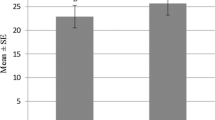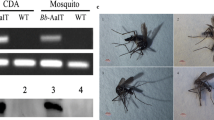Abstract
Paratransgenesis consists of genetically engineering an insect symbiont to control vector-borne diseases. Biosafety assessments are a prerequisite for the use of genetically modified organisms (GMOs). Assessments rely on the measurement of the possible impacts of GMOs on different organisms, including beneficial organisms, such as pollinators. The bacterium Serratia AS1 has been genetically modified to express anti-Plasmodium effector proteins and does not impose a fitness cost on mosquitoes that carry it. In the present study, we assessed the impact of this bacterium on the native bee Partamona helleri (Meliponini), an ecologically important species in Brazil. Serratia eGFP AS1 (recombinant strain) or a wild strain of Serratia marcescens were suspended in a sucrose solution and fed to foragers, followed by measurements of survival, feeding rate, and behavior (walking and flying). These bacteria did not change any of the variables measured at 24, 72, and 144 h after the onset of the experiment. Recombinant and wild bacteria were detected in the homogenates of digestive tract during the 144 h period analyzed, but their numbers decreased with time. The recombinant strain was detected in the midgut at 24 h and in the hindgut at 72 h and 144 h after the onset of the experiment under the fluorescent microscope. As reported for mosquitoes, Serratia eGFP AS1 did not compromise the foragers of P. helleri, an ecologically relevant bee.







Similar content being viewed by others
Data Availability
The two bacterial strains used in the experiments are stored in the Laboratório de Biologia Molecular de Insetos at UFV, Brazil. The data that support the findings are available from the corresponding author upon request.
References
World Health Organization (2019) World malaria report 2019. World Health Organization. https://apps.who.int/iris/handle/10665/330011. License: CC BY-NC-SA 3.0 IGO
Coutinho-Abreu IV, Zhu KY, Ramalho-Ortigão M (2010) Transgenesis and paratransgenesis to control insect-borne diseases: current status and future challenges. Parasitol Int 59(1):1–8. https://doi.org/10.1016/j.parint.2009.10.002
Wang S, Jacobs-Lorena M (2013) Genetic approaches to interfere with malaria transmission by vector mosquitoes. Trends Biotechnol 31(3):185–193. https://doi.org/10.1016/j.tibtech.2013.01.001
Pumpuni CB, Beier MS, Nataro JP, Guers LD, Davis JR (1993) Plasmodium falciparum: inhibition of sporogonic development in Anopheles stephensi by gram-negative bacteria. Exp Parasitol 77(2):195–199. https://doi.org/10.1006/expr.1993.1076
Gusmão DS, Santos AV, Marini DC, Russo ES, Peixoto AM, Bacci Júnior M, Berbert-Molina MA, Lemos FJ (2007) First isolation of microorganisms from the gut diverticulum of Aedes aegypti, Diptera: Culicidae: new perspectives for an insect-bacteria association. Mem Inst Oswaldo Cruz 102(8):919–924. https://doi.org/10.1590/S0074-02762007000800005
Maleki-Ravasan N, Oshaghi MA, Hajikhani S, Saeidi Z, Akhavan AA, Gerami-Shoar M, Shirazi MH, Yakhchali B, Rassi Y, Afshar D (2013) Aerobic microbial community of insectary population of Phlebotomus papatasi. J Arthropod-Borne Dis 18(1):69–81
Li CH, Jie CAO, Zhou YZ, Zhang HS, Gong HY, Zhou JL (2014) The midgut bacterial flora of laboratory-reared hard ticks, Haemaphysalis longicornis, Hyalomma asiaticum, and Rhipicephalus haemaphysaloides. J Integr Agric 13:1766–1771. https://doi.org/10.1016/S2095-3119(13)60517-1
Botina LL, Vélez M, Barbosa WF, Mendonça AC, Pylro VS, Tótola MR, Martins GF (2019) Behavior and gut bacteria of Partamona helleri under sublethal exposure to a bioinsecticide and a leaf fertilizer. Chemosphere 234:187–195. https://doi.org/10.1016/j.chemosphere.2019.06.048
Elston KM, Perreau J, Maeda GP, Moran NA, Barrick JE (2020) Engineering a culturable Serratia symbiotica strain for aphid paratransgenesis. Appl EnvironMicrobiol 87(4):e02245-e2320. https://doi.org/10.1128/AEM.02245-20
Wang S, Dos-Santos AL, Huang W, Liu KC, Oshaghi MA, Wei G, Agre P, Jacobs-Lorena M (2017) Driving mosquito refractoriness to Plasmodium falciparum with engineered symbiotic bacteria. Science 357(6358):1399–1402. https://doi.org/10.1126/science.aan5478
Koosha M, Vatandoost H, Karimian F, Choubdar N, Abai MR, Oshaghi MA (2018) Effect of Serratia AS1 (Enterobacteriaceae: Enterobacteriales) on the fitness of Culex pipiens (Diptera: Culicidae) for paratransgenic and RNAi approaches. J Med Entomol 56(2):553–559. https://doi.org/10.1093/jme/tjy183
Koosha M, Vatandoost H, Karimian F, Choubdar N, Oshaghi MA (2019) Delivery of a genetically marked Serratia AS1 to medically important arthropods for use in RNAi and paratransgenic control strategies. Microb Ecol 78(1):185–194. https://doi.org/10.1007/s00248-018-1289-7
Ghosh AK, Ribolla PE, Jacobs-Lorena M (2001) Targeting Plasmodium ligands on mosquito salivary glands and midgut with a phage display peptide library. PNAS 98(23):13278–13281. https://doi.org/10.1073/pnas.241491198
Vega-Rodríguez J, Ghosh AK, Kanzok SM, Dinglasan RR, Wang S, Bongio NJ, Kalume DE, Miuraf K, Long CA, Pandey A, Jacobs-Lorena M (2014) Multiple pathways for Plasmodium ookinete invasion of the mosquito midgut. PNAS 111(4):E492–E500. https://doi.org/10.1073/pnas.1315517111
Conde R, Zamudio FZ, Rodrı́guez MH, Possani LD, (2000) Scorpine, an anti-malaria and anti-bacterial agent purified from scorpion venom. FEBS Lett 471(2–3):165–168. https://doi.org/10.1016/S0014-5793(00)01384-3
Jaynes JM, Burton CA, Barr SB, Jeffers GW, Julian GR, White KL, Enright FM, Klei TR, Laine RA (1988) In vitro cytocidal effect of novel lytic peptides on Plasmodium falciparum and Trypanosoma cruzi. FASEB J 2(13):2878–2883. https://doi.org/10.1096/fasebj.2.13.3049204
CTNBio nº 24, de 07.01.2020 <https://www.mctic.gov.br/mctic/opencms/legislacao/outros_atos/resolucoes/Resolucao_Normativa_CTNBio_n_24_de_07012020.html?fbclid=IwAR3tstN7JdacfZtV3yn94BCItKulfulpJ3XNHXxDOP-1NE5TsdwSTREUH5A> (Accessed 18 April 2020)
Eggers B, Mackenzie R (2000) The Cartagena protocol on biosafety. J Int Econ Law 3(3):525–543. https://doi.org/10.1093/jiel/3.3.525
Engel P, Kwong WK, McFrederick Q, Anderson KE, Barribeau SM, Chandler JA, Cornman SR, Dainat J, Miranda JR, Doublet V, Emery O, Evans JD, Farinelli L, Flenniken ML, Granberg F, Grasis JA, Gauthier L, Hayer J, Koch H, Kocher S, Martinson VG, Moran N, Munoz-Torres M, Newton I, Paxton RJ, Powell E, Sadd BM, Schmid-Hempel P, Schmid-Hempel R, Song SJ, Schwarz RS, Dennis vanEngelsdorp D, Dainatab B, (2016) The bee microbiome: impact on bee health and model for evolution and ecology of host-microbe interactions. MBio 7(2):e02164-e2215. https://doi.org/10.1128/mBio.02164-15
Eckerstorfer M, Benedict M, Franz G, Gaugitsch H, Greiter A, Heissenberger A, Knol B, Kumschick S, Nentwig W, Rabitsch W (2012) Defining environmental risk assessment criteria for GM insects to be placed on the EU market. IOBC/wprs Bulletin 73:45–50. https://doi.org/10.2903/sp.efsa.2010.EN-71
Allen-Wardell G, Bernhardt P, Bitner R, Burquez A, Buchmann S, Cane J, Cox PA, Dalton V, Feinsinger P, Ingram M, Inouye D, Jones CE, Kennedy K, Kevan P, Koopowitz H, Medellin R, Medellin-Morales S, Nabhan GP, Pavlik B, Tepedino V, Torchio P, Walker S (1998) The potential consequences of pollinator declines on the conservation of biodiversity and stability of food crop yields. Conserv Biol 8-17. https://doi.org/10.1046/j.1523-1739.1998.97154.x
Slaa E, Sánchez Chaves L, Malagodi-Braga K, Hofstede F (2006) Stingless bees in applied pollination: practice and perspectives. Apidologie 37(2):293–315. https://doi.org/10.1051/apido:2006022
Villa S, Vighi M, Finizio A, Serini GB (2000) Risk assessment for honeybees from pesticide-exposed pollen. Ecotoxicology 9(4):287–297. https://doi.org/10.1023/A:1026522112328
Malone LA, Pham-Delègue MH (2001) Effects of transgene products on honey bees (Apis mellifera) and bumblebees (Bombus sp.). Apidologie 32(4):287–304. https://doi.org/10.1051/apido:2001130
Romeis J, Bartsch D, Bigler F, Candolfi MP, Gielkens MM, Hartley SE, Hellmich RL, Huesing JE, Jepson PC, Layton R, Quemada H, Raybould A, Rose RI, Schiemann J, Sears MK, Shelton AM, Sweet J, Vaituzis Z, Wolt JD (2008) Assessment of risk of insect-resistant transgenic crops to nontarget arthropods. Nat Biotechnol 26(2):203–208. https://doi.org/10.1038/nbt1381
Thompson HM (2010) Risk assessment for honey bees and pesticides—recent developments and ‘new issues.’ Pest Manag Sci 66(11):1157–1162. https://doi.org/10.1002/ps.1994
Kerr WE, Carvalho GA, Nascimento VA (1996) Abelha uruçu: biologia, manejo e conservação (vol. 2). Fundação Acangaú. 36pp
Desneux N, Decourtye A, Delpuech JM (2007) The sublethal effects of pesticides on beneficial arthropods. Annu Rev Entomol 52:81–106. https://doi.org/10.1146/annurev.ento.52.110405.091440
Lima MAP, Martins GF, Oliveira EE, Guedes RNC (2016) Agrochemical-induced stress in stingless bees: peculiarities, underlying basis, and challenges. J Comp Physiol 202(9–10):733–747. https://doi.org/10.1007/s00359-016-1110-3
Barbosa WF, Smagghe G, Guedes RNC (2015) Pesticides and reduced-risk insecticides, native bees and pantropical stingless bees: pitfalls and perspectives. Pest Manag Sci 71(8):1049–1053. https://doi.org/10.1002/ps.4025
Giannini TC, Boff S, Cordeiro GD, Cartolano EA, Veiga AK, Imperatriz-Fonseca VL, Saraiva AM (2015) Crop pollinators in Brazil: a review of reported interactions. Apidologie 46(2):209–223. https://doi.org/10.1007/s13592-014-0316-z
Li JH, Evans JD, Li WF, Zhao YZ, DeGrandi-Hoffman G, Huang SK, Li ZG, Hamilton M, Chen YP (2017) New evidence showing that the destruction of gut bacteria by antibiotic treatment could increase the honey bee’s vulnerability to Nosema infection. PloS One 12(11):e0187505. https://doi.org/10.1371/journal.pone.0187505
Raymann K, Shaffer Z, Moran NA (2017) Antibiotic exposure perturbs the gut microbiota and elevates mortality in honeybees. PLoS Biol 15(3):e2001861. https://doi.org/10.1371/journal.pbio.2001861
Zheng H, Steele MI, Leonard SP, Motta EV, Moran NA (2018) Honey bees as models for gut microbiota research. Lab Anim 47(11):317–325. https://doi.org/10.1038/s41684-018-0173-x
Raymann K, Moran NA (2018) The role of the gut microbiome in health and disease of adult honey bee workers. Curr Opin Insect Sci 26:97–104. https://doi.org/10.1016/j.cois.2018.02.012
Kwong WK, Medina LA, Koch H, Sing KW, Soh EJY, Ascher JS, Jaffé R, Moran NA (2017) Dynamic microbiome evolution in social bees. Sci Adv 3(3):e1600513. https://doi.org/10.1126/sciadv.1600513
Burritt NL, Foss NJ, Neeno-Eckwall EC, Church JO, Hilger AM, Hildebrand JA, Warshauer DM, Perna NT, Burritt JB (2016) Sepsis and hemocyte loss in honey bees (Apis mellifera) infected with Serratia marcescens strain sicaria. PLoS One 11(12):e0167752. https://doi.org/10.1371/journal.pone.0167752
Botina LL, Bernardes RC, Barbosa WF, Lima MAP, Guedes RN, Martins GF (2020) Toxicological assessments of agrochemical effects on stingless bees (Apidae, Meliponini). MethodsX 100906. https://doi.org/10.1016/j.mex.2020.100906
Rodrigues CG, Krüger AP, Barbosa WF, Guedes RNC (2016) Leaf fertilizers affect survival and behavior of the neotropical stingless bee Friesella schrottkyi (Meliponini: Apidae: Hymenoptera). J Econ Entomol 109(3):1001–1008. https://doi.org/10.1093/jee/tow044
Morton RD (2001) Aerobic plate count. In: Dowes FP, Ito K (ed) Compendium of methods for the microbiological examination of foods, 4th edn. APHA, pp183–193
Bernardes RC, Lima MAP, Guedes RNC, da Silva CB, Martins GF (2021) Ethoflow: computer vision and artificial intelligence-based software for automatic behavior analysis. Sensors 21(9):3237. https://doi.org/10.3390/s21093237
Tomé HVV, Barbosa WF, Martins GF, Guedes RNC (2015) Spinosad in the native stingless bee Melipona quadrifasciata: regrettable non-target toxicity of a bioinsecticide. Chemosphere 124:103–109. https://doi.org/10.1016/j.chemosphere.2014.11.038
Westfall PH (1997) Multiple testing of general contrasts using logical constraints and correlations. J Am Stat Assoc 92:299–306. https://doi.org/10.1080/01621459.1997.10473627
R Core Team (2018) R: a language and environment for statistical computing. R Foundation for Statistical Computing, Vienna. https://www.R-project.org
Pu YC, Hou YM (2016) Isolation and identification of bacterial strains with insecticidal activities from Rhynchophorus ferrugineus Oliver (Coleoptera: Curculionidae). J Appl Entomol 140(8):617–626. https://doi.org/10.1111/jen.12293
Muhammad A, Habineza P, Ji T, Hou Y, Shi Z (2019) Intestinal microbiota confer protection by priming the immune system of Red Palm Weevil Rhynchophorus ferrugineus Olivier (Coleoptera: Dryophthoridae). Front Physiol 10:1303. https://doi.org/10.3389/fphys.2019.01303
Kwong WK, Engel P, Koch H, Moran NA (2014) Genomics and host specialization of honey bee and bumble bee gut symbionts. PNAS 111(31):11509–11514. https://doi.org/10.1073/pnas.1405838111
Anderson KE, Sheehan TH, Eckholm BJ, Mott BM, DeGrandi-Hoffman G (2011) An emerging paradigm of colony health: microbial balance of the honey bee and hive (Apis mellifera). Insectes Soc 58(4):43. https://doi.org/10.1007/s00040-011-0194-6
Grüter C, Acosta LE, Farina WM (2006) Propagation of olfactory information within the honeybee hive. Behav Ecol Sociobiol 60(5):707–715. https://doi.org/10.1007/s00265-006-0214-0
Acknowledgements
The authors thank Dr. Maria Cristina Dantas Vanetti for providing the wild Serratia strain, Prof. Dr. Hilário Cuquetto Mantovani (Departamento de Microbiologia—UFV) and Dr. Tania Maria Fernandes Salomão (Departamento de Biologia Geral—UFV) for assistance with bacteria handling.
Funding
This work was supported by the Coordenação de Aperfeiçoamento de Pessoal de Nível Superior (CAPES—001), Conselho Nacional de Desenvolvimento Científico e Tecnológico (CNPq—301725/2019–5) and Fundação de Amparo à Pesquisa do Estado de Minas Gerais (FAPEMIG, CBB-APQ-00247–14), NIH grant R01AI031478, and the Bloomberg Philanthropies.
Author information
Authors and Affiliations
Contributions
TAV, WFB, RCB, MJL, and GFM conceived this research and designed experiments; TAV, LLBJ, and RCB collected the data; TAV, WFB, LLBJ, RCB, JSS, and GFM analyzed the data; TAV and GFM wrote and reviewed the manuscript. TAV, WFB, LLBJ, JSS, MJL, and GFM corrected the work, contributed critically to the drafts, and approved it for publication.
Corresponding author
Ethics declarations
Research Involving Human Participants and/or Animals
No approval of research ethics committees was required to accomplish the goals of this study because experimental work was conducted with an unregulated invertebrate species.
Informed Consent
Not applicable.
Conflict of Interest
The authors declare no competing interests.
Supplementary Information
Below is the link to the electronic supplementary material.
Supplementary file2 (MP4 26908 KB)
Supplementary file3 (MP4 26908 KB)
Supplementary file4 (MP4 2175 KB)
Supplementary file5 (MP4 26915 KB)
Rights and permissions
About this article
Cite this article
Viana, T.A., Barbosa, W.F., Jojoa, L.L.B. et al. A Genetically Modified Anti-Plasmodium Bacterium Is Harmless to the Foragers of the Stingless Bee Partamona helleri. Microb Ecol 83, 766–775 (2022). https://doi.org/10.1007/s00248-021-01805-9
Received:
Accepted:
Published:
Issue Date:
DOI: https://doi.org/10.1007/s00248-021-01805-9




